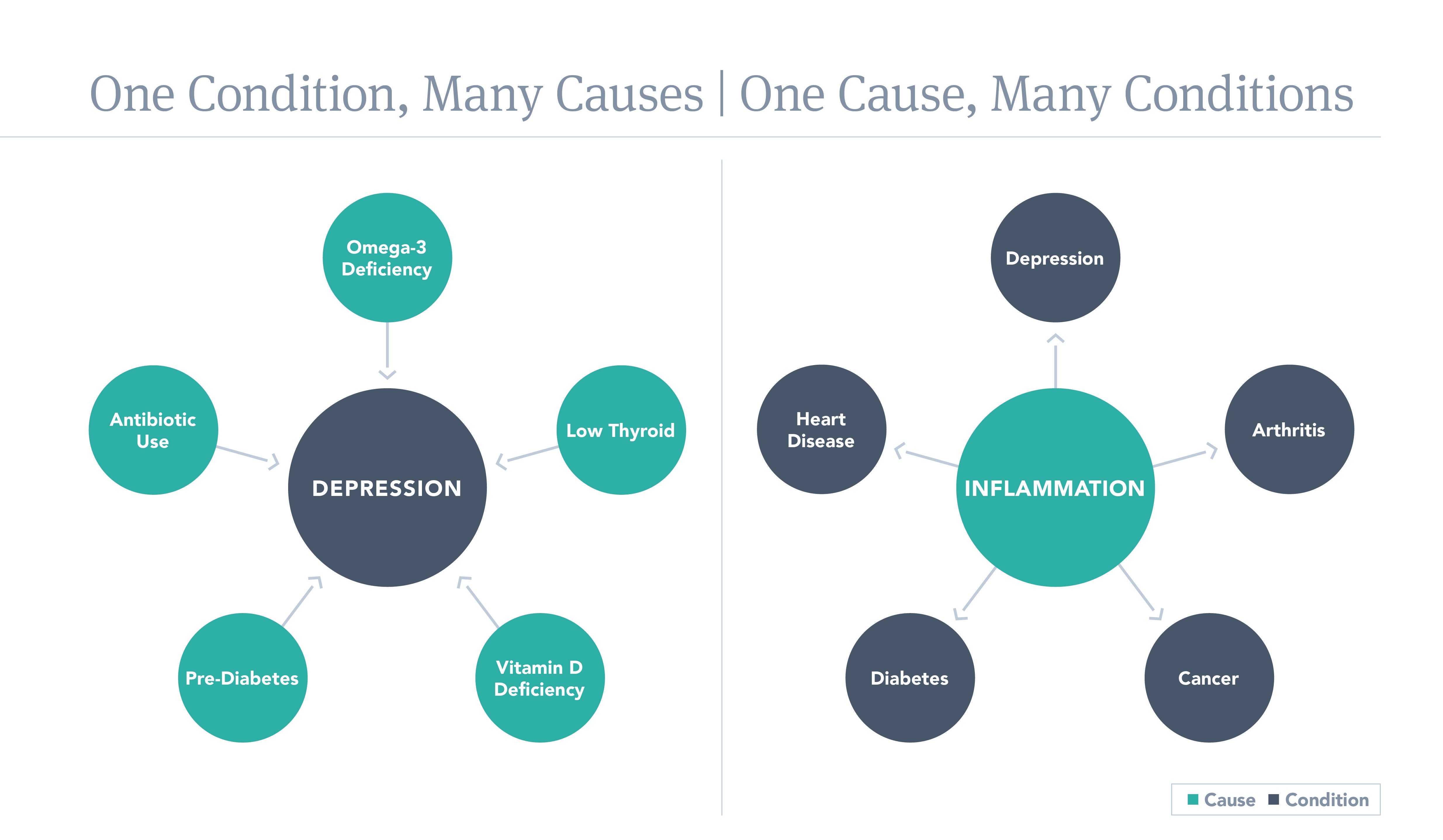What is Functional Medicine?
The Functional Medicine Approach
Functional medicine is a systems biology–based approach that focuses on identifying and addressing the root cause of disease. Each symptom or differential diagnosis may be one of many contributing to an individual’s illness.
As the graphic illustrates, a diagnosis can be the result of more than one cause. For example, depression can be caused by many different factors, including inflammation. Likewise, a cause such as inflammation may lead to a number of different diagnoses, including depression. The precise manifestation of each cause depends on the individual’s genes, environment, and lifestyle, and only treatments that address the right cause will have lasting benefit beyond symptom suppression.

Merging Science and Practice
The Functional Medicine Model
The functional medicine model evolved from the insights and perspectives of a small group of influential thought leaders who realized the importance of an individualized approach to disease causes based on the evolving research in nutritional science, genomics, and epigenetics. These thought leaders found ways to apply these new advances in the clinic to address root causes using low-risk interventions that modify molecular and cellular systems to reverse these drivers of disease. LEARN MORE
These functional medicine thought leaders were able to apply new research in a way that often brought dramatic results to patients who had previously received unsuccessful treatments. Part of this advance was a return to scientific principles of finding new ways to look for unifying factors at the cellular and systems levels that underlie organism-wide problems. Learn More
As others became interested in learning functional medicine, it became necessary to systematize the approach so that it could be taught to a wider group of practitioners of differing backgrounds. The IFM approach to applying functional medicine is mainly practiced through a set of tools that formalizes both history-taking and mapping symptoms to the categories of root processes that underlie illness. Three of these tools are the functional medicine Matrix, Timeline, and the GOTOIT framework. More information about each may be found below.



IFM's Clinical Tools
In addition to being the founders of the functional medicine model, The Institute for Functional Medicine developed a set of tools that are used exclusively in its education programs.
The Functional Medicine Matrix
The functional medicine Matrix assists the clinician in organizing and prioritizing each patient’s health issues as elicited by a thorough personal, family, social, and medical history. The Matrix is akin to a web decoder—it organizes what seems to be disparate issues into a complete story to help the clinician gain a comprehensive perspective of the patient and subsequently facilitate discussion of complex, chronic disease with the patient.
Timeline
All clinicians take patient history, but what makes the functional medicine Timeline different is that it has the effect of giving the patient insight into previous life events to motivate them to change and participate in treatment. As an intake tool for organizing the patient’s history chronologically, the functional medicine Timeline is a graphical representation that allows clinicians to identify factors that predispose, provoke, and contribute to pathological changes and dysfunctional responses in the patient. In this way, practitioners will be able to view temporal relationships among events, which can reveal cause-effect relationships that might otherwise go unnoticed. By covering the period from preconception to the present, the Timeline reflects the connection between the whole lifespan and one’s current health.
GOTOIT
“GOTOIT” is a simple framework practitioners can use to discover the root of each patient’s dysfunction and subsequently apply individualized treatments that address specific causes. Standing for “Gather, Organize, Tell, Order, Initiate, and Track,” GOTOIT is a teaching tool to help practitioners complete the Matrix and Timeline. Using the GOTOIT framework can help providers establish rapport with their patients, identify unhealthy patterns, get to the root cause of their problem, and propose appropriate, personalized treatments and lifestyle modifications.
